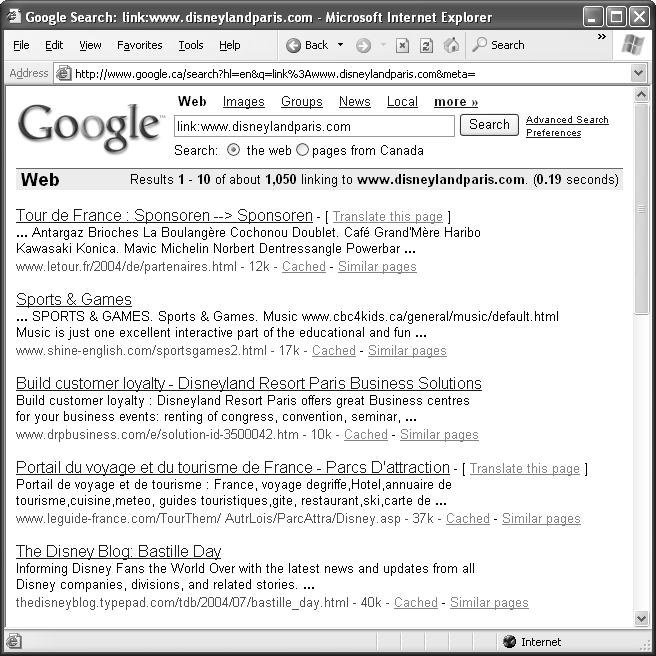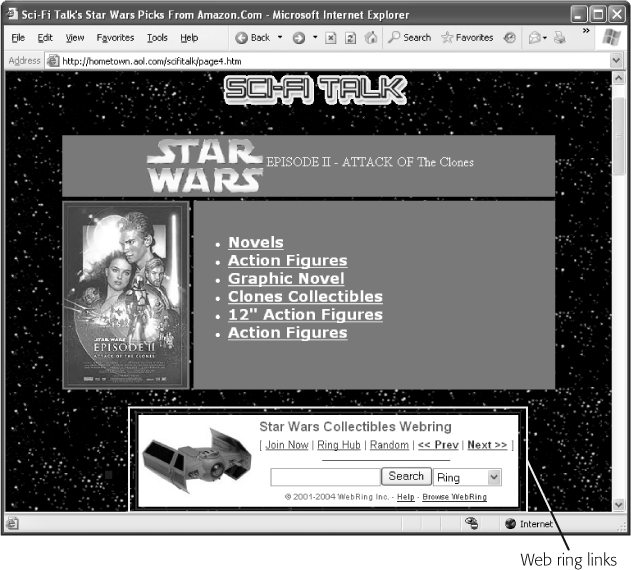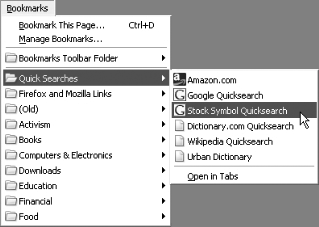Some of the most effective promotion you can do doesn't involve any high-tech XHTML wonkery, but instead amounts to variations on the theme of good old-fashioned advertising.
The first step is to find other Web sites like yours. If you create a topic-oriented site—your musings on, say, golf, fine jewelry, or jeweled golf clubs—similar sites make up your virtual neighborhood. They're part of a larger online community to which you now belong. So why not introduce yourself? Strike up a reciprocal link relationship (see the next section).
On the other hand, if you're creating a business site, similar sites are, obviously, your competitors. As a result, you're unlikely to share links. However, it's a great idea to Google your competition. You'll probably find service sites—business directories, news sites, content sites, and so on—that link to these competitors. Once you find these service sites, you can publicize your site there as well.
A reciprocal link is a link-trading agreement. The concept is simple. You find a Web site with similar content and strike a bargain: Link to my site, and I'll link to yours. Reciprocal links are an important thread in the underlying fabric of the Web. If you're not sure where to start searching for potential link buddies, pay a visit to Google and use the link: operator (as explained in Figure 11-1) to see who's linking to sites similar to yours. (You can get an even more powerful link viewer as part of the Google Webmaster Tools, described on Google AdWords.)
Reciprocal links only work if there's a logical connection between the two sites. For example, if you create the Web site www.ChocolateSculptures.com, it probably makes sense to exchange links with www.101ChocolateRecipes.com. But www.HomerSimpsonForPresident.com is a far stretch, no matter how much traffic it gets.
Topic isn't the only consideration in link exchanges. You should also look for sites that feel professional. If a similarly themed site is choked with ads, barren of content, formatted with fuchsia text on a black background, and was last updated circa 1998, keep looking.
Once you find a site you want to exchange links with, dig around on the site for the Webmaster's email address. Send a message explaining that you love www.101ChocolateRecipes.com, and plan to link to it from your site, www.ChocolateSculptures.com. Then, gently suggest that you think your Web site would be of great interest to www.101ChocolateRecipes.com readers.
Tip
Reciprocal linking can require a little finesse. It's best to look for sites that complement yours, but don't necessarily compete with it. You'll also have more luck if you approach Web peers, sites of similar quality or with a similar amount of traffic to yours.
Figure 11-1. Google has a little-known but valuable search keyword that identifies sites that link to your site (or anyone else's for that matter). It's the link: operator. If you type in link:www.disneylandparis.com, for example, you see all the sites that link to EuroDisney's home page. You can use any URL you want (for example, try link:www.disneylandparis.com/uk/introduction.htm to find out who's linking to the English-language intro page).
Once you enter into a link agreement—even if it's just an informal exchange of emails—remember to keep your end of the deal. Don't remove the link from your site without letting the other Webmaster know about the change. It's also a good idea to keep checking on the other site to make sure your link remains prominent. If it disappears, don't fly into an Othellian rage—just send a polite email asking where it went or why it disappeared.
Reciprocal links are also a good way to start working your way up search engine rankings (see Rising up in the rankings). That's because one of the criteria Google takes into account when it determines how to order the results of a Web search is how many other sites link to yours. The more popular you are, the more likely you'll climb up the list.
Note
There are some companies that sell reciprocal link services. The basic idea is that they try to pair up different Web sites (for a fee) in a link-sharing agreement. Don't fall for it. Your traffic might increase, but the visitors you get won't really be interested in the content of your site, and they won't hang around for long.
A Web ring is similar to a reciprocal link, but instead of sharing a link between two partners, it binds a group of Web sites together.
For example, imagine you create a brilliant new site featuring reality TV trivia. To get more exposure, you can join a Web ring dedicated to reality TV. You agree to put a block of XHTML on your site that advertises the ring and lets your visitors go to other sites in it. As payback, you become another stop within the ring (see Figure 11-2). Web rings are almost exclusively the province of topic-based sites.
Figure 11-2. Many Web ring sites don't list the formal address of all the member sites. Instead, visitors move from one site to the next using previous and next links. This sequence of sites makes up the "ring."
Sadly, the majority of Web rings consist of gaudy, amateurish Web disasters. Pair up with these nightmares and your site will be deemed guilty by association. However, with a little research, you may find a higher-quality ring. Maybe. To search for one, use Google (enter the topic followed by the words "Web ring").
Note
The biggest disadvantage to Web rings is that they usually require you to add a fairly ugly set of links to your page. Before you sign up, carefully evaluate whether the extra traffic is worth it, and travel to all the other sites in the ring to see if they're of similar quality. If you're in a ring with low-quality sites, it can hurt your reputation.
To get your Web site listed on many of the Web's most popular sites, you need to fork over some cold, hard cash. However, some of the best advertising doesn't cost anything. The trick is to look for sites where you can promote and contribute at the same time.
For example, if you create the Web site www.HotComputerTricks.com, why not answer a few questions on a computing newsgroup or discussion board? It's considered tactless to openly promote your site, but there's nothing wrong with dispensing some handy advice and following it up with a signature that includes your URL.
Here's an example of how you can answer a poster's question and put in a good word for yourself at the same time:
Jim,
The problem is that most hard drives will fail when submerged in water. Hence, your fishing computer idea won't work.
Sasha Mednick
An answer posting is much better than sending an email directly to the original poster because on a popular site hundreds of computer aficionados with the same question will read your posting. If even a few decide to check out your site, you've made great progress.
If you're very careful, you might even get away with something that's a little more explicit:
Jim,
The problem is that most hard drives will fail when submerged in water. Hence, your fishing computer idea won't work. However, you might want to check out my homemade hard-drive vacuum enclosure (www.HotComputerTricks.com), which I developed to solve the same problem.
Sasha Mednick
Warning
This maneuver requires a very light touch. The rule of thumb is that your message should be well-intentioned. Only direct someone to your site if there really is something specific there that addresses the question.
Some sites let you post tips, reviews, or articles. If that's the case, you can use a variation of the technique above. Remember, dispense useful advice, and then follow it up with a byline at the end of your message. For example, if you submit a free article that describes how to create your groundbreaking vacuum enclosure, end it with this:
Sasha Mednick is a computer genius who runs the first-rate computing Web site www.HotComputerTricks.com.
Promotion always works best if you believe in your product. So make sure there's some relevant high-quality content on your site before you boast about it. Don't ever send someone to your site based on some content you plan to add (someday).
Tip
If you're a business trying to promote a product, you'll get further if you recruit other people to help you spread the word. One excellent idea is to look for influential bloggers—people who create Web sites with the personal posting format you'll learn about in Chapter 17. For example, if you're trying to sell a new type of fluffy toddler towel pajamas, hunt down popular people with blogs about parenting. Then, offer them some free pajamas if they'll offer their thoughts in a blog review. This sort of word-of-mouth promotion can be dramatically more successful in the wide-reaching communities of the Web than it is in the ordinary offline world.
Attracting fresh faces is a critical part of Web site promotion, but novice Webmasters often forget something equally important—return visitors. For a Web site to become truly popular, it needs to attract visitors who return again and again. Many a Web site creator would do better to spend less time trying to attract new visitors and more time trying to keep the current flock.
If you're a marketer, you know that a customer who comes back to the same store three or four times is a lot more likely to make a purchase than someone who's there on a first visit. These regulars are also more likely to get excited and recruit their friends to come and take a look. This infectious enthusiasm can lead more and more people to your Web site's virtual doorstep. The phenomenon is so common it has a name: the traffic virus.
Note
Return visitors are the ultimate measuring stick of Web site success. If you can't interest someone enough to come back again, your Web site's just not fulfilling its destiny.
So how does your Web site become a favorite stopping point for Web travelers? The old Internet adage says it all—content is king. Your site needs to be chock full of fascinating must-read information. Just as important, this information needs to change regularly and noticeably. If you update information once a month, your Web site barely has a pulse. But if you update it two or more times a week, you're ready to flourish.
Never underestimate the importance of regular updates. It takes weeks and months of up-to-date information to create a return visitor. However, one dry spell—say, three months without changing anything more than the color of your buttons—doesn't just stop attracting newcomers, it can kill off your current roster of return visitors. That's because savvy visitors immediately realize when a Web site's gone stale. They have much the same sensation you feel when you pull out a once-attractive pastry from the fridge and find it's as hard as igneous rock. You know what happens next—it's time to toss the pastry away, clear out the Web site bookmarks, and move on.
Tip
Signs of a stale site include old-fashioned formatting, broken links, and references to old events (like a Spice Girls CD release party or a technical analysis of why Florida condos are an ironclad investment).
The other way to encourage return visitors is to build a community. Discussion forums, promotional events, and newsletters are like glue. They encourage visitors to feel like they're participating in your site and sharing your Web space. If you get this right, hordes of visitors will move in and never want to leave. You'll learn specific techniques for community-building in the next chapter.


